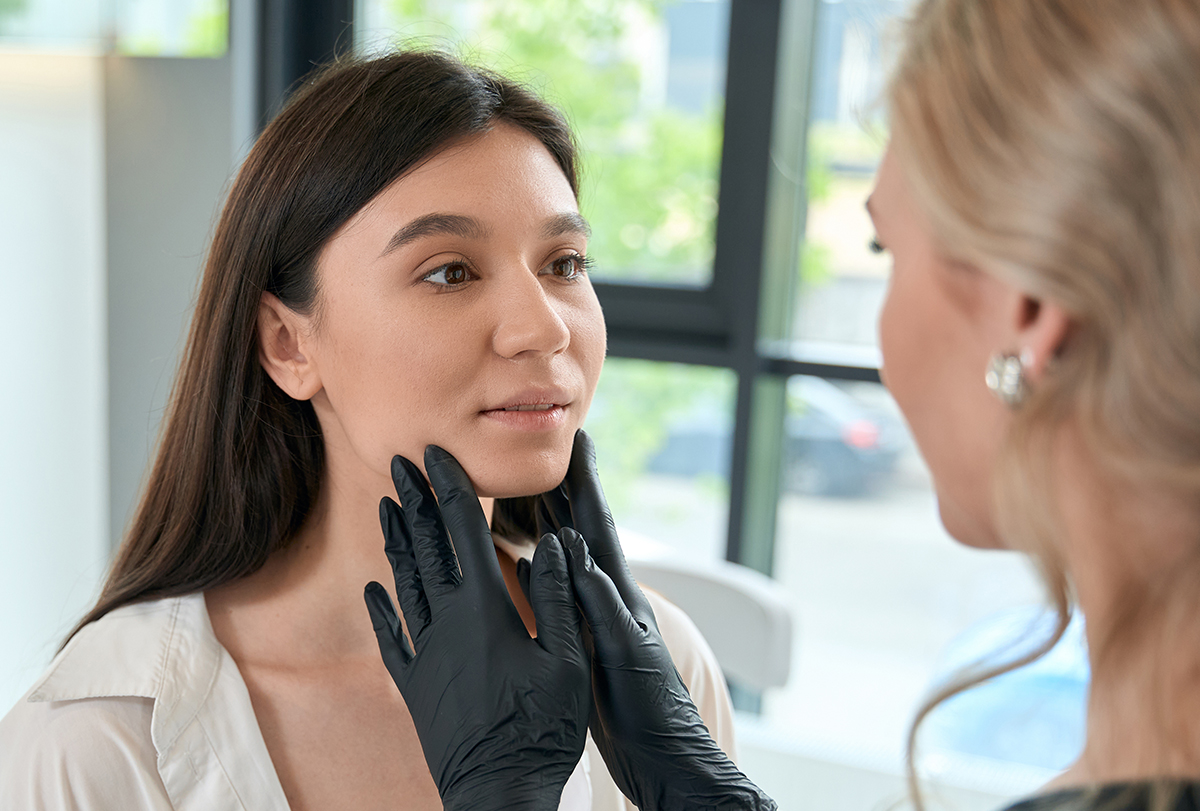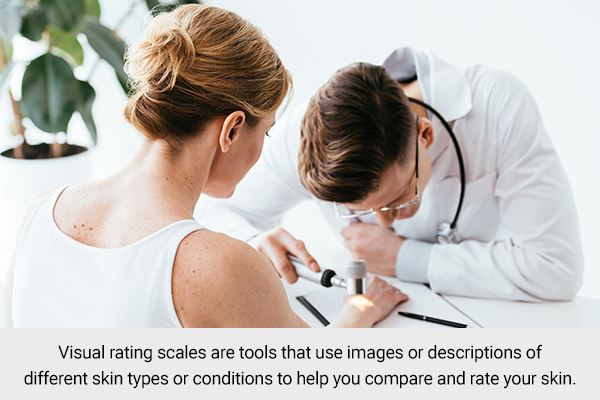In this article:
Different people have different types of skin with specific needs and concerns. Thus, you cannot follow a one-size-fits-all approach in skin care.

A particular skin product or treatment may not suit all skin types or show the same kind of efficacy on all skin types. You need to understand what kind of skin you have and then choose skin care products or treatments that suit it the most.
By and large, there are five main skin types:
- Normal skin, which is smooth, clear, and not sensitive
- Oily skin, which appears shiny and has a greasy texture
- Dry skin, which is flaky, rough, and itchy
- Sensitive skin, which tends to get easily irritated after washing or applying products
- Combination skin, which is dry in some areas and oily in others (1)
How to Identify Your Skin Type at Home?
There are different types of methods of testing your skin type at home.
1. Tissue test/blotting sheet method
The tissue test is a quick and easy technique to determine how oily your skin is.
- Wash your face with a gentle cleanser and water.
- Pat your face dry.
- Wait for an hour to let your skin come back to its natural state. Don’t put any product or makeup on your face during this period.
- Dab a clean tissue or blotting paper on different parts of the face (forehead, nose chin, and cheeks) to pick up any oil residue.
If the tissue or blotting paper turns greasy on your entire face, then your skin type is classified as oily. If the tissue only picks up oil over the T-zone, then you have combination skin.
If the tissue or blotting paper does not get greasy after dabbing it all over the face, then your skin is dry. If the tissue or blotting paper only turns a little damp but does not have any trace of oil, then you have normal skin.
If the tissue or blotting paper does not show any oil but your face does feel itchy or irritated after the rinse, then your skin type may be sensitive.
2. Wash test
The wash test is another simple technique to identify your skin type based on the way your skin feels after cleansing.
- Use a mild cleanser and water to wash your face.
- Pat your skin dry.
- Keep your face completely bare and product-free for the next half an hour.
- Notice how different areas of the face feel thereafter.
If you have dry or combination skin, you will experience tightness all over the face or in certain areas of the face. If you have sensitive skin, you tend to develop itchiness or irritation all over your face or in specific areas of the face.
If your entire face feels cleansed, light, and calm, then your skin type is normal. If your face turns oily, clogged, or shiny all over or in patches, then you have oily or combination skin.
Professional Techniques to Identify Skin Type
While the above-listed methods can give you a cursory idea of your skin type, it is still best to visit a dermatologist for a more reliable and thorough skin evaluation. They generally use the following tools to accurately identify your skin type as well as any underlying conditions or concerns. (2)

1. Visual rating scales
Visual rating scales are tools that use images or descriptions of different skin types or conditions to help you compare and rate your skin. They are usually based on expert opinions or scientific evidence and are designed to assess specific aspects of your skin, such as its color, oiliness, dryness, sensitivity, and aging signs. (2)
Some examples of visual rating scales are:
- The Fitzpatrick Skin Phototype Classification: This scale classifies skin types based on skin tone and how the skin reacts to sunlight. It ranges from type I, which is extremely fair skin that has a tendency to get sunburn rather than tan, to type VI, which is deeply pigmented skin that doesn’t get sunburnt but tans easily. This scale can help you determine your risk of sun damage and skin cancer and choose the appropriate sun protection measure for your skin type. (2)
- The Baumann Skin Type System: This system identifies 16 different skin types based on four parameters: oily versus dry, sensitive versus resistant, pigmented versus nonpigmented, and wrinkled versus tight. It uses a questionnaire with 64 questions to help you determine your skin type and provides personalized recommendations for skin care products and routines. (2)
- The Griffiths Photo Numeric Scale: This scale classifies skin types based on facial aging signs such as wrinkles, pigmentation, sagging, and texture. It uses photographs of different age groups and genders to help you compare and rate your skin on a scale from 1 (no signs of aging) to 9 (severe signs of aging). This scale can help you assess your skin aging status and monitor the effects of antiaging treatments. (2)
- The Glogau Scale: This scale classifies skin types based on facial aging signs, such as wrinkles and photodamage, into four categories: mild (no wrinkles), moderate (wrinkles in motion), advanced (wrinkles at rest), and severe (only wrinkles). This scale can help you evaluate the extent of your skin aging and choose the best cosmetic treatments accordingly. (2)
2. Self-report instruments
Self-report instruments are tools that use questions or statements to collect information about your skin type or condition from your perspective.
They are usually based on scientific research or validated criteria and are designed to measure specific aspects of your skin, such as its hydration, sebum production, sensitivity, or elasticity.
Self-report instruments are more objective and precise than visual rating scales and can provide quantitative data that can be compared or monitored over time. (2)
Some examples of self-report instruments are:
- The Corneometer – This uses an electrical capacitance method to evaluate the level of skin hydration. It provides a numerical value that indicates the amount of water present in the stratum corneum, which is the most superficial layer of the skin. A higher number implies greater skin hydration. (3)
- The Sebumeter – This employs a photometric method to measure how much sebum is produced by the skin. It provides a numerical value that stands for the amount of sebum on the skin’s surface. A higher value corresponds to higher sebum production. (4)
- The Cutometer – This uses a suction method to assess skin elasticity. It provides several parameters that indicate the firmness, resilience, and viscoelasticity of the skin. A higher value means higher elasticity. (5)
Most-Asked Questions
Can your skin type change?
Yes, your skin type can become different over time on account of various factors such as age, hormones, diet, lifestyle, environment, and other health-related issues.
For instance, stress, medication, and food choices can alter the amount of sebum produced by the skin. Moving to a different climate can induce minor or major changes in your skin type.
Moreover, stress triggers the release of an inflammatory hormone called cortisol, which can flare up acne.
What are the names of the three layers and five sublayers of the skin?
The skin is broadly composed of three layers, and the epidermis is the outermost layer, followed by the middle layer called the dermis, which lies on top of the deepest layer of the skin called the hypodermis or subcutaneous tissue.
The epidermis is further divided into the following five sublayers. Starting from the innermost to the outermost, these sublayers are:
- Stratum basale
- Stratum Spinosum
- Stratum granulosum
- Stratum lucidum
- Stratum corneum or the skin surface (6)
Final Word
Identifying your skin type is the first step toward formulating an effective skin care routine. It helps you choose the best possible products and treatments for your skin needs and goals. You can also avoid ingredients and products that may cause adverse reactions or worsen your skin problems.
Given that several intrinsic and extrinsic factors can transform your skin type over time, you need to monitor your skin regularly and adjust your skin care routine accordingly.
- Was this article helpful?
- YES, THANKS!NOT REALLY


